Getting Started in Radio Control Aircraft
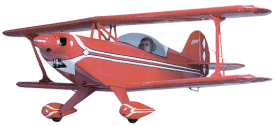 Welcome to the world of radio controlled model airplanes. This certainly must be one of the most exciting and enjoyable hobbies in existence, encompassing so many different interests. What other hobby involves aerodynamics, woodworking, composite materials, electronics, mechanics, small motors, drafting, artistry, fresh air and the outdoors, and club activities—practically all at the same time!
Welcome to the world of radio controlled model airplanes. This certainly must be one of the most exciting and enjoyable hobbies in existence, encompassing so many different interests. What other hobby involves aerodynamics, woodworking, composite materials, electronics, mechanics, small motors, drafting, artistry, fresh air and the outdoors, and club activities—practically all at the same time!
If you have not already seen an R/C aircraft in action, head to the local club field when there is some activity, meet some of the fliers and get to enjoy it first hand. Once you see it, you’ll be hooked!
The first thing one must realize about a radio controlled model aircraft is that it is not a toy. The model is a real aircraft which flies and operates by the same principles as its full-scale counterpart—the only difference is size and weight. Models fly at speeds between 10 and 160 MPH with the average trainer flying between 40 and 60 MPH! These are not slow vehicles, nor can they be flown in an average backyard—they require space! And just like their bigger brothers, they require a learned skill to be controlled properly. It is not simply a matter of pushing a button to take off, another to land, etc.
Most people, after they have become acquainted with the hobby, realize it is more complex than they may have first believed—it is more than just boys playing with their toys! By the same token, the challenge of learning the new skills required makes the hobby that much more enjoyable and satisfying. It is not a hobby with which one easily gets bored! You will garner years of enjoyment from the hobby, especially if you get started on the right foot.
There are two steps you should take to get yourself flying the fastest and in the most enjoyable way. The first is to get involved with the local club or group of people that fly in your area. Their experience and help will be invaluable to you in both building your aircraft and learning to fly. The second is to outfit yourself with a good trainer aircraft for your first plane. This is not the time in your modeling career to build and fly that P-51 Mustang you’ve been fantasizing about.
What You Will Need . . .
The following is a description of the items required to start flying a glow-powered, radio controlled model aircraft. Keep in mind, there is a wide selection available for each one of these items.
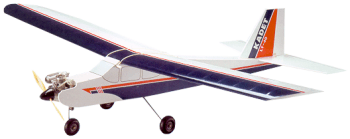 The Plane
The Plane
As mentioned previously, you should select a model that is designed specifically for training the new pilot. Typically these aircraft will have a high wing, simple sturdy construction, excellent plans and instructions, and be easy to fly. In this guide, we show you some of the best choices for a model and what you will require to go with it.
Perhaps the first decision to make with regard to your first model is whether you want to build a complete kit or just do some simple assembly with an "Almost-Ready-to-Fly" (ARF) model. An ARF model will usually have the bulk of the construction completed and it will even be covered. Usually the only assembly to be done is joining the wing halves, adding the tail surfaces, mounting the radio system, engine and landing gear, and connecting the control surfaces. The building of a complete kit is more involved, and certainly takes more time, but on the same token, it is usually more satisfying to those so inclined. Also, when you build your own model from a box of wood and plastic parts, you become familiar with aircraft construction and if the day comes when you have to do some repair work, you may find it easier, having done the building in the first place.
You can also get an ARF combo which comes with just about everything you will need, plus it has more of the work done for you—the engine and radio come installed! Generally it will take less than an hour to get it flying!
Another consideration when choosing your first plane is how many control functions or channels (one radio channel—not to be confused with frequency—for each function) you wish to use. Trainer aircraft are available in both three channel and four channel configurations. Most aircraft fly with four channels, these being the Rudder, Elevator, Throttle, and Ailerons. Trainers, however, can also fly without the use of ailerons. A greater dihedral (angle of the wings from the horizontal) on these trainers makes them more stable and can also produce gentle turns using rudder only. Usually a three channel model flies more slowly and is easier to fly than one with four functions and a flatter wing. Four channel models can usually handle the wind a bit better, however, and most trainers tend to be configured this way. Check with your local instructor to see which type of model he recommends and is more comfortable teaching with. If you are learning on your own—which we strongly do not recommend—you should have a much better chance with a three channel model than a four. We would also recommend using a simulator for learning.
There are generally a number of additional items that will be necessary when building a kit. Most kits supply the airframe of the model and do not contain such things as the radio system, the engine, wheels, covering material, and items related to the engine such as fuel tank, fuel tubing, propeller, spinner, etc. ARF models usually contain most items except radio, engine and propeller. With each model we offer here, we will show you all the items necessary to complete it.
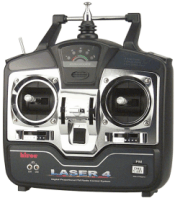 The Radio
The Radio
Along with your aircraft, you will need a radio to control it. Most aircraft radio systems have four or more channel capability and come with just about everything you need including the rechargeable battery packs. Refer to our Introduction to Radio Systems section for more information on this.
One thing you may want to look for when buying your first radio is "buddy box" capability. The "buddy box" is where two radio transmitters may be connected together through a cable—the instructor holds one and the student holds the other. The student can have control over the model as long as the instructor holds a spring loaded trainer switch on his transmitter. If the student gets into trouble, the instructor releases the switch and regains full control of the model. This can greatly decrease the learning time and also be good insurance against accidents with the novice pilot. Check with the local club or instructor to see if they have "buddy box" capability and if so, you may wish to purchase a compatible radio system.
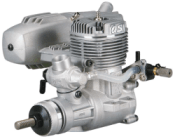 The Engine
The Engine
To power your model airplane you will require an engine. The most common type of engine for model aircraft is the glow engine. Gas engines are not common in trainer aircraft. For more information on engines refer to our Introduction to Model Engines section.
Tools
Whether you’re building a complete kit or just assembling an ARF model you will certainly need a few basic tools and some adhesives.
![]()
The most common tools used in building kits include a modeling knife (such as a #1 Hobby Knife), T-pins (for holding parts over your full-size plans), a small razor plane, a fine razor saw, small screw drivers, pliers, etc. A sealing iron will be needed to apply covering to the completed airframe. A drill with standard size bits can come in very handy as well. Other, more expensive tools such as a Dremel® rotary tool are also of benefit to the modeler but are not absolutely necessary to the beginner.
Adhesives
 There are a variety of adhesives used in building models and you will need some of these for completion of your project. The most commonly used adhesive today is the cyanoacrylate (similar to the famous “Crazy Glues”). These are now specially formulated for working with wood in various thicknesses and setting speeds.
There are a variety of adhesives used in building models and you will need some of these for completion of your project. The most commonly used adhesive today is the cyanoacrylate (similar to the famous “Crazy Glues”). These are now specially formulated for working with wood in various thicknesses and setting speeds.
The thin cyanoacrylate is the fastest curing (usually 3 to 5 seconds!) and is best suited to balsa wood where the joint is good fitting and has a solid contact surface. The parts should be joined first and then the thin cyanoacrylate applied to the joint. The glue will wick into the joint and form a solid bond. The thicker or “gap-filling” cyanoacrylate is great for general purpose building where balsa, spruce or light plywood is involved. Apply the adhesive to the parts and then join. Drying time is in the order of 5 to 10 seconds. The thickest cyanoacrylate, also referred to as “slow-setting”, can be used like the “gap-filling” cyanoacrylate where slightly longer cure times might be desired. Drying is in the order of 30 seconds to a minute.
All cyanoacrylates may be cured more quickly with the aid of an accelerator or “kicker” which is sprayed onto the joint after gluing.
Another family of adhesives which is very popular in constructing models is Epoxy. This is a two part adhesive which is mixed and then applied to the surface to be bonded. Epoxy is especially useful when working with foam parts as it will not attack the Styrofoam. Epoxies are very strong and many kits recommend it specifically for certain parts of the construction.
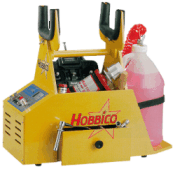 Field Equipment
Field Equipment
There will also be a few basic items needed for airplane support at the field when you are actually ready to fly your model.
First, you will need fuel (usually sold by the gallon jug) and a way of getting it from the container into the fuel tank. This could be as simple as a bulb fuel pump or hand pump, or more complex like a battery powered electric fuel pump.
The second basic necessity is power for your glow plug. As described in our Introduction to Model Engines section, a glow engine needs to have current flowing through the element in its glow plug before it can start running. This current is supplied by a 1.2 to 1.5 volt battery or by an adjustable circuit called a glow driver, frequently found on power panels. The power panel gets its power from a 12V battery.
Additional field support items should include a prop/glow plug wrench, a “chicken-stick” for starting your engine, and a few basic tools.
Once into the hobby, most modelers will go with field support consisting of the following: A flight box to hold everything; a power panel; a 12 volt battery to power the power panel; a charger to charge the 12 volt battery; a glow plug clip to apply power to the glow plug from the power panel; an electric fuel pump which can be operated from the power panel; fuel line, filters, and cap fittings for the fuel container to connect to the pump and the fuel tank; a 12 volt electric starter which can be powered from the power panel; a 4-way glow plug/prop wrench; miscellaneous tools; spare glow plugs; and spare propellers. The level of field support you choose initially will usually depend on how much you want to spend right away.

